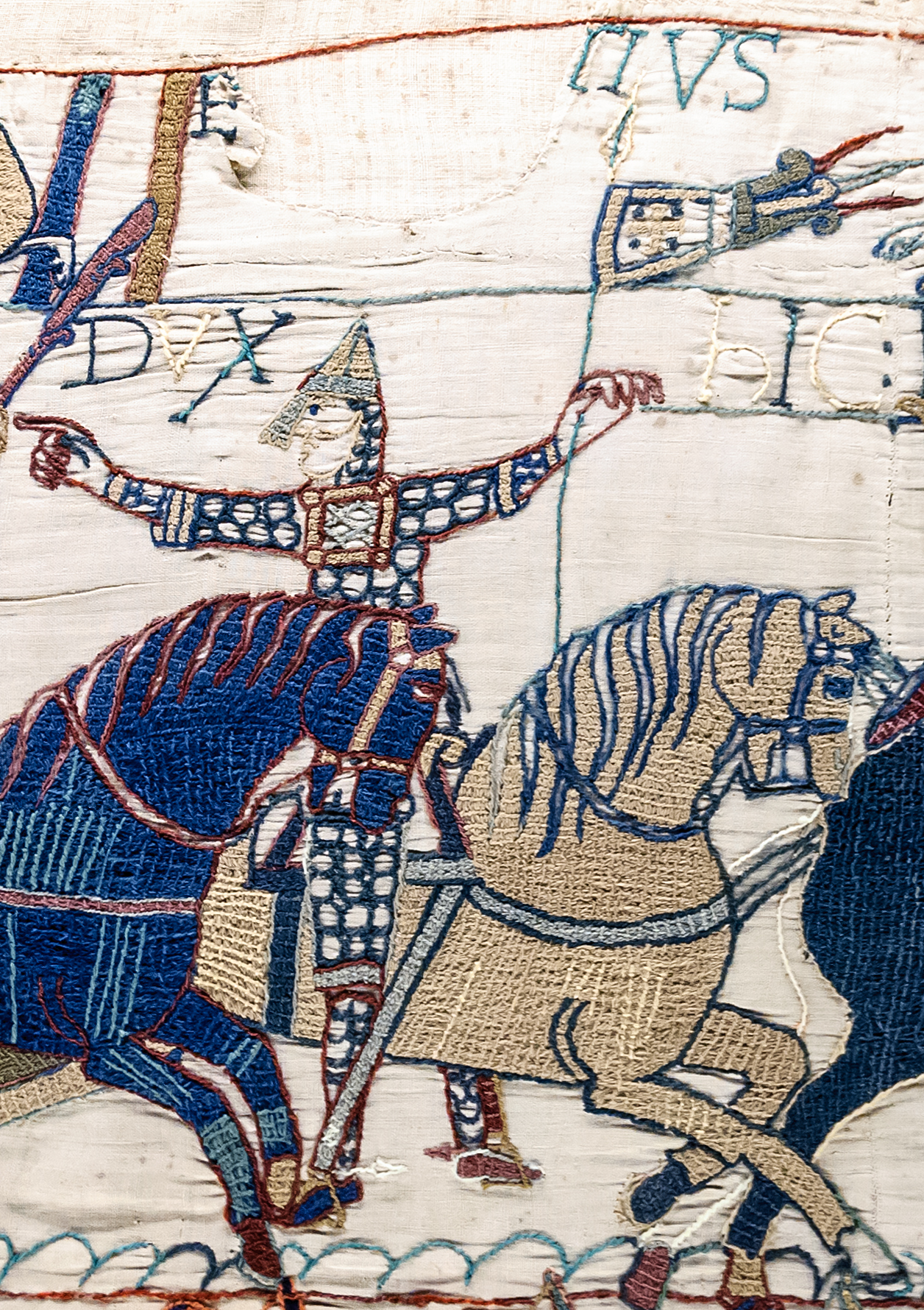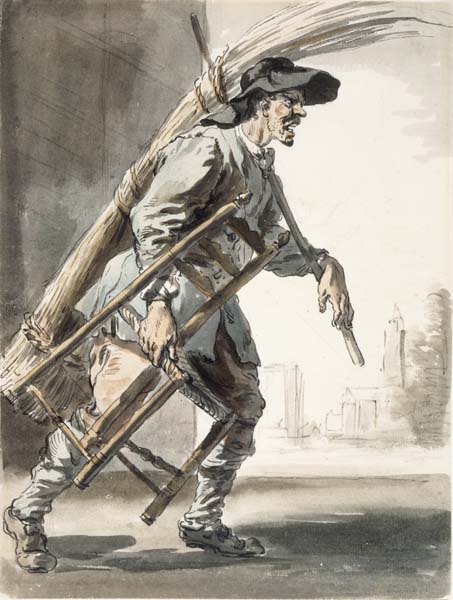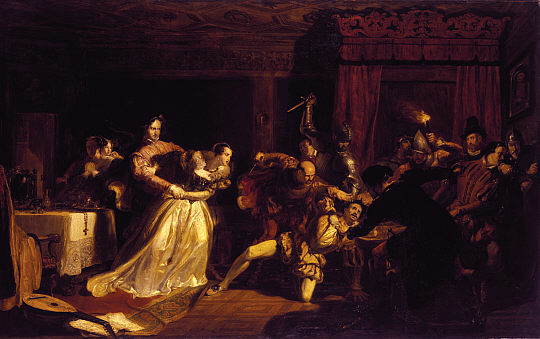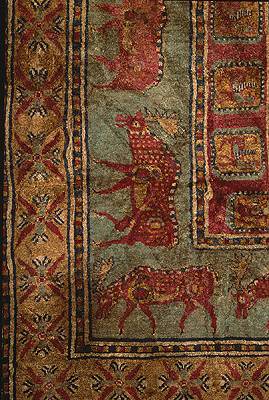|
Turkeywork
Turkeywork (alternately turkey-work or turkey work; sometimes called setwork and Norwich work) is a knotted-and-cut pile furnishing textile produced in England from the sixteenth to the mid-eighteenth centuries. Turkeywork was used for table carpets, cupboard carpets, cushions, and especially for matched upholstery sets for chair seats and backs.Swain, Margaret. "The Turkey-work Chairs of Holyrood House" in Production Turkeywork was produced by professional weavers in England from the 16th century. Short lengths or thrums of worsted wool were hand-knotted using the Turkish or Ghiordes knot (also called the symmetrical knot) on a linen or hemp-fibre warp. The colorful wool was shorn to produce a dense, even pile. Designs originally imitated so-called 'Turkey carpets', the general name in Early Modern England for imported carpets of Middle Eastern origin, which became popular for furniture covers (and less often, floor carpets) in the 16th century. It is sometimes said tha ... [...More Info...] [...Related Items...] OR: [Wikipedia] [Google] [Baidu] |
Knotted-pile Carpet
A knotted-pile carpet is a carpet containing raised surfaces, or piles, from the cut off ends of knots woven between the warp and weft. The Ghiordes/Turkish knot and the Senneh/Persian knot, typical of Anatolian carpets and Persian carpets, are the two primary knots.Goswami, K.K.; ed. (2009). ''Advances in Carpet Manufacture'', p.239. Woodhead Publishing in Textiles: Number 87 ( The Textile Institute). . "The two most common types of knot used in an oriental carpet are the Persian knot and the Turkish knot." A flat or tapestry woven carpet, without pile, is a kilim. A pile carpet is influenced by width and number of warp and weft, pile height, knots used, and knot density. "The structural weft threads alternate with supplementary weft that rises from the surface of the weave at a perpendicular angle. This supplementary weft is attached to the warp by one of three knots... to form the pile or nap of the carpet." Knots are tied in rows, one to each pair of warp threads, which may ... [...More Info...] [...Related Items...] OR: [Wikipedia] [Google] [Baidu] |
Upholstery
Upholstery is the work of providing furniture, especially seats, with padding, springs, webbing, and fabric or leather covers. The word also refers to the materials used to upholster something. ''Upholstery'' comes from the Middle English word ''upholder'', which referred to an artisan who makes fabric furnishings. The term is equally applicable to domestic, automobile, airplane and boat furniture, and can be applied to mattresses, particularly the upper layers, though these often differ significantly in design. A person who works with upholstery is called an ''upholsterer''. An apprentice upholsterer is sometimes called an ''outsider'' or ''trimmer''. Traditional upholstery uses materials like coil springs (post-1850), animal hair (horse, hog and cow), coir, straw and hay, hessians, linen scrims, wadding, etc., and is done by hand, building each layer up. In contrast, today's upholsterers employ synthetic materials like dacron and vinyl, serpentine springs, and so on. H ... [...More Info...] [...Related Items...] OR: [Wikipedia] [Google] [Baidu] |
Palace Of Whitehall
The Palace of Whitehall – also spelled White Hall – at Westminster was the main residence of the English monarchs from 1530 until 1698, when most of its structures, with the notable exception of Inigo Jones's Banqueting House of 1622, were destroyed by fire. Henry VIII moved the royal residence to Whitehall after the old royal apartments at the nearby Palace of Westminster were themselves destroyed by fire. Although the Whitehall palace has not survived, the area where it was located is still called Whitehall and has remained a centre of the British government. Whitehall was at one time the largest palace in Europe, with more than 1,500 rooms, before itself being overtaken by the expanding Palace of Versailles, which was to reach 2,400 rooms. At its most expansive, the palace extended over much of the area bordered by Northumberland Avenue in the north; to Downing Street and nearly to Derby Gate in the south; and from roughly the elevations of the current buildings fac ... [...More Info...] [...Related Items...] OR: [Wikipedia] [Google] [Baidu] |
Textile Industry Of England
Textile is an Hyponymy and hypernymy, umbrella term that includes various Fiber, fiber-based materials, including fibers, yarns, Staple (textiles)#Filament fiber, filaments, Thread (yarn), threads, and different types of #Fabric, fabric. At first, the word "textiles" only referred to woven fabrics. However, weaving is not the only manufacturing method, and many other methods were later developed to form textile structures based on their intended use. Knitting and Nonwoven, non-woven are other popular types of fabric manufacturing. In the contemporary world, textiles satisfy the material needs for versatile applications, from simple daily clothing to Bulletproof vest, bulletproof jackets, spacesuits, and Medical gown, doctor's gowns. Textiles are divided into two groups: consumer textiles for domestic purposes and technical textiles. In consumer textiles, Aesthetics (textile), aesthetics and Textile performance#Comfort, comfort are the most important factors, while in techn ... [...More Info...] [...Related Items...] OR: [Wikipedia] [Google] [Baidu] |
Needlepoint
Needlepoint is a type of canvas work, a form of embroidery in which yarn is stitched through a stiff open weave canvas. Traditionally needlepoint designs completely cover the canvas. Although needlepoint may be worked in a variety of stitches, many needlepoint designs use only a simple tent stitch and rely upon color changes in the yarn to construct the pattern. Needlepoint is the oldest form of canvas work. The degree of detail in needlepoint depends on the thread count of the underlying mesh fabric. Due to the inherent lack of suppleness of needlepoint, common uses include eyeglass cases, holiday ornaments, pillows, purses, upholstery, and wall hangings. History The roots of needlepoint go back thousands of years to the ancient Egyptians, who used small slanted stitches to sew up their canvas tents. Howard Carter, of Tutankhamen fame, found some needlepoint in the cave of a Pharaoh who had lived around 1500 BC. Modern needlepoint descends from the canvas work in tent s ... [...More Info...] [...Related Items...] OR: [Wikipedia] [Google] [Baidu] |
Embroidery
Embroidery is the art of decorating Textile, fabric or other materials using a Sewing needle, needle to stitch Yarn, thread or yarn. It is one of the oldest forms of Textile arts, textile art, with origins dating back thousands of years across various cultures. Common Embroidery stitch, stitches found in early embroidery include the chain stitch, Buttonhole stitch, buttonhole or blanket stitch, running stitch, satin stitch, and cross stitch. Modern embroidery continutes to utilize traditional techniques, though many contemporary stitches are exclusive to machine embroidery. Embroidery is commonly used to embellish accessories and garments is usually seen on quilts, clothing, and accessories. In addition to thread, embroidery may incorporate materials such as Pearl, pearls, Bead, beads, Quill, quills, and Sequin, sequins to highlight texture and design. Today, embroidery serves both decorative and functional purposes and is utilized in fashion expression, cultural identity, and ... [...More Info...] [...Related Items...] OR: [Wikipedia] [Google] [Baidu] |
William And Mary Style
What later came to be known as the William and Mary style is a furniture design common from 1700 to 1725 in the Netherlands, Kingdom of England, Kingdom of Scotland and Kingdom of Ireland, and later in England's American colonies. It was a transitional style between Mannerist furniture and Queen Anne furniture. Sturdy, emphasizing both straight lines and curves, and featuring elaborate carving and woodturning, the style was one of the first to imitate Asian design elements such as japanning. About the design In 1688, James II of England was deposed by his daughter, Mary, and her husband, William of Orange, in what came to be known as the "Glorious Revolution". From birth in 1650, William had reigned over five provinces of the Dutch Republic, and Mary had lived in the Netherlands with him after their marriage in 1677. William and Mary brought to their kingdoms a taste for Dutch furniture styles, as well as a number of Dutch furniture-makers. Although movement toward what woul ... [...More Info...] [...Related Items...] OR: [Wikipedia] [Google] [Baidu] |
Caning (furniture)
In the context of furniture, caning is a method of weaving chair seats and other furniture, either while building new chairs or in the process of cane chair repair. Furniture or chair caning may be confused with wicker; chair caning is specifically the craft of applying rattan cane or rattan peel to a piece of furniture such as the backs or seats of chairs, whereas wicker or wicker work is a reference to the craft of weaving any number of materials such as willow or rattan reeds as well as man-made paper based cords. Rattan In common use, the term ''cane'' may refer to any plant with a long, thin stem. However, the cane used for furniture is derived from the rattan vine native to Indonesia, the Philippines, and Malaysia. The vines typically grow to in length; most have a diameter less than . Before export, the rattan stems are cut to uniform lengths and the bark is removed in narrow strips of . Sugar cane and bamboo (sometimes called "cane" in the southern United States) shoul ... [...More Info...] [...Related Items...] OR: [Wikipedia] [Google] [Baidu] |
Holyrood Palace
The Palace of Holyroodhouse ( or ), commonly known as Holyrood Palace, is the official residence of the British monarch in Scotland. Located at the bottom of the Royal Mile in Edinburgh, at the opposite end to Edinburgh Castle, Holyrood has served as the principal royal residence in Scotland since the 16th century, and is a setting for state occasions and official entertaining. The palace adjoins Holyrood Abbey, and the gardens are set within Holyrood Park. The King's Gallery, Edinburgh, King's Gallery was converted from existing buildings at the western entrance to the palace and was opened in 2002 to exhibit works of art from the Royal Collection. Charles III, King Charles III spends one week in residence at Holyrood at the beginning of summer, where he carries out a range of official engagements and ceremonies. The 16th-century historic apartments of Mary, Queen of Scots, and the State Apartments, used for official and state entertaining, are open to the public throughout ... [...More Info...] [...Related Items...] OR: [Wikipedia] [Google] [Baidu] |
Oriental Rug
An oriental rug is a heavy textile made for a wide variety of utilitarian and symbolic purposes and produced in "Orient, Oriental countries" for home use, local sale, and export. Oriental carpets can be knotted-pile carpet, pile woven or Kilim, flat woven without pile, using various materials such as silk, wool, cotton, jute and animal hair. Examples range in size from pillows to large, room-sized carpets, and include carrier bags, floor coverings, decorations for animals, Islamic prayer rugs ('Jai'namaz'), Jewish Torah ark covers (''parochet''), and Christian altar covers. Since the High Middle Ages, oriental rugs have been an integral part of their cultures of origin, as well as of the European and, later on, the North American culture. Geographically, oriental rugs are made in an area referred to as the “Rug Belt”, which stretches from Morocco across North Africa, the Middle East, and into Central Asia and northern India. It includes countries such as Armenia, northern Chi ... [...More Info...] [...Related Items...] OR: [Wikipedia] [Google] [Baidu] |
England
England is a Countries of the United Kingdom, country that is part of the United Kingdom. It is located on the island of Great Britain, of which it covers about 62%, and List of islands of England, more than 100 smaller adjacent islands. It shares Anglo-Scottish border, a land border with Scotland to the north and England–Wales border, another land border with Wales to the west, and is otherwise surrounded by the North Sea to the east, the English Channel to the south, the Celtic Sea to the south-west, and the Irish Sea to the west. Continental Europe lies to the south-east, and Ireland to the west. At the 2021 United Kingdom census, 2021 census, the population was 56,490,048. London is both List of urban areas in the United Kingdom, the largest city and the Capital city, capital. The area now called England was first inhabited by modern humans during the Upper Paleolithic. It takes its name from the Angles (tribe), Angles, a Germanic peoples, Germanic tribe who settled du ... [...More Info...] [...Related Items...] OR: [Wikipedia] [Google] [Baidu] |
Oriental Carpets In Renaissance Painting
Carpets of Middle-Eastern origin, either from Anatolia, Persia, Armenia, Levant, the Mamluk state of Egypt or Northern Africa, were used as decorative features in Western European paintings from the 14th century onwards. More depictions of Oriental carpets in Renaissance painting survive than actual carpets contemporary with these paintings. Few Middle-Eastern carpets produced before the 17th century remain, though the number of these known has increased in recent decades. Therefore, comparative art-historical research has from its onset in the late 19th century relied on carpets represented in datable European paintings. Art historical background Activities of scientists and collectors beginning in the late 19th century have substantially increased the corpus of surviving Oriental carpets, allowing for more detailed comparison of existing carpets with their painted counterparts. Western comparative research resulted in an ever more detailed cultural history of the Oriental ... [...More Info...] [...Related Items...] OR: [Wikipedia] [Google] [Baidu] |









